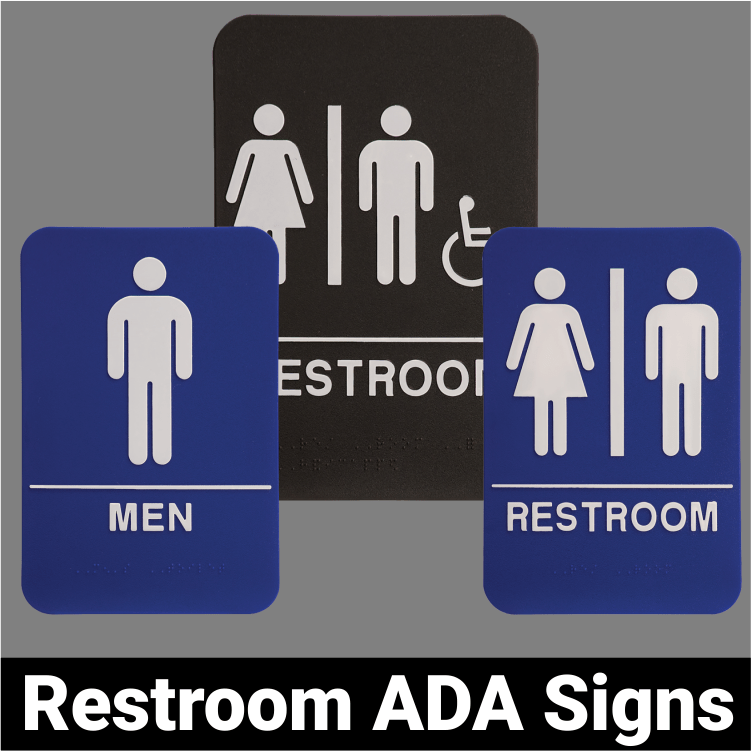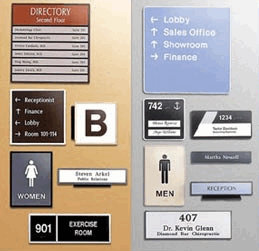Discovering Imaginative Styles for Effective ADA Signs
Discovering Imaginative Styles for Effective ADA Signs
Blog Article
ADA Signage: Making Sure Ease Of Access and Compliance in Public Spaces
ADA signs plays a crucial duty in ensuring access and conformity within public spaces, considerably adding to an inclusive environment for individuals with impairments. As we discover the subtleties of ADA signs, from responsive features to develop ins and outs, it's critical to consider exactly how these elements coalesce to copyright the civil liberties of all customers.
Importance of ADA Signs
In contemporary culture, the relevance of ADA signs extends beyond mere compliance with lawful mandates to symbolize a commitment to inclusivity and access for all people. These indicators are essential in producing environments where individuals with disabilities can navigate public spaces with the same ease and self-reliance as those without impairments. By giving standardized and clear information, ADA signs guarantees that everyone can access centers, services, and information without obstacles.
The relevance of ADA signage exists in its capacity to boost the high quality of life for people with handicaps by advertising equal gain access to. It gets rid of the barriers that might or else prevent their ability to take part totally in area life. Moreover, these signs work as visible indications of a company's dedication to diversity and equality, reflecting broader social worths that promote the civil liberties and dignity of all individuals.
In addition, ADA signs plays a critical duty in public security. By assisting people to departures, toilets, and other vital facilities, it ensures that all people, no matter physical ability, can evacuate safely throughout emergencies. In summary, ADA signs is not just a regulatory demand however an effective device for promoting a equitable and comprehensive society.
Trick Components of Conformity

Positioning is crucial; indications should be installed in locations that are reachable and conveniently noticeable. Usually, signs needs to be placed between 48 and 60 inches from the ground to ensure ease of access for both standing and mobility device customers. Tactile elements, such as Braille, are essential for people with aesthetic problems, giving important info in a non-visual format.
High-contrast colors between the text and background are required to enhance readability for people with low vision. The ADA mandates certain comparison ratios to make sure quality. Additionally, personality dimension is a key factor to consider, with minimal height demands dictated by the watching distance to make certain readability from various angles.
Style Considerations for Access
Creating easily accessible signage requires a careful approach to guarantee it fulfills the requirements of all customers, particularly those with specials needs. The dimension of the text is equally important, with ADA guidelines recommending a minimal height based on seeing distance to make sure readability.
Contrasting shades in between text and background are crucial for visibility, especially for people with visual impairments. A useful link high comparison proportion aids distinguish the message from its history, enhancing readability under numerous lights problems. Additionally, responsive components, such as Braille and elevated characters, are crucial for individuals who are blind or have reduced vision. These components need to be found at a regular height and position to guarantee easy gain access to and understanding.
Furthermore, the placement of signs plays a considerable duty in ease of access. Indicators should be installed in locations that are easily obtainable and unobstructed. Guaranteeing that signage is mounted at proper elevations and angles allows all users, including those making use of mobility devices, to interact with them successfully.
Usual Mistakes to Prevent

Another widespread mistake is the incorrect positioning of signage. ADA standards specify specific elevation and area requirements to make sure that signs are easily noticeable and obtainable by all individuals, consisting of those utilizing wheelchairs. Neglecting these standards not just obstructs ease of access but also risks non-compliance with lawful standards.
Additionally, not enough contrast in between message and background is a constant oversight. Sufficient contrast is important for readability, especially for people with reduced vision. Developers often choose colors that are visually appealing but do not have the required comparison, rendering the message difficult to determine.
Lastly, some designers stop working to include responsive components, such as Braille, which are vital for people that are blind. Omitting these functions not only causes non-compliance with ADA regulations yet likewise limits gain access to More Bonuses for a section of the populace that counts on responsive info.
Future Trends in Signage
Innovations in modern technology and boosting understanding of inclusivity are forming the future trends in signage style. Digital signs, for circumstances, is evolving to include interactive functions and real-time updates, which can be essential in supplying vibrant details in public spaces.
Another arising fad is the use of augmented reality (AR) to improve customer experience. AR-enabled signs can overlay electronic information onto the physical environment, providing aesthetically damaged people with auditory or haptic responses. ADA Signs. This innovation not only enhances ease of access but likewise develops an appealing experience for all users
Sustainability is additionally a substantial aspect affecting signage fads. Environment-friendly materials and energy-efficient illumination services are being focused on to straighten with global environmental objectives. Additionally, innovations in products scientific research are bring about the advancement of even more long lasting and weather-resistant indications.
Final Thought
ADA signage plays an essential role in ensuring access and compliance within public areas by incorporating tactile aspects, high-contrast colors, and calculated positioning. The adherence to ADA standards not just promotes risk-free navigating for people with handicaps yet likewise signifies a company's dedication to diversity and inclusivity. By staying clear of usual errors and accepting future patterns, public areas can remain to advance these values, making certain that the legal rights and dignity of all people are appreciated and promoted.
ADA signage plays an essential duty in ensuring ease of access and compliance within public spaces, considerably adding to a comprehensive environment for individuals with disabilities. As we explore the nuances of ADA signage, from responsive features to develop ins and outs, it's crucial to think about just how these components coalesce to maintain the legal rights of all users.In contemporary society, the importance of ADA signage expands beyond plain conformity with legal mandates to embody a commitment to inclusivity and ease of access for all individuals. By supplying standardized and clear details, ADA signage guarantees that everybody can access centers, solutions, and details without barriers.
ADA signs plays view publisher site a crucial duty in assuring availability and compliance within public spaces by incorporating responsive components, high-contrast colors, and strategic positioning. (ADA Signs)
Report this page